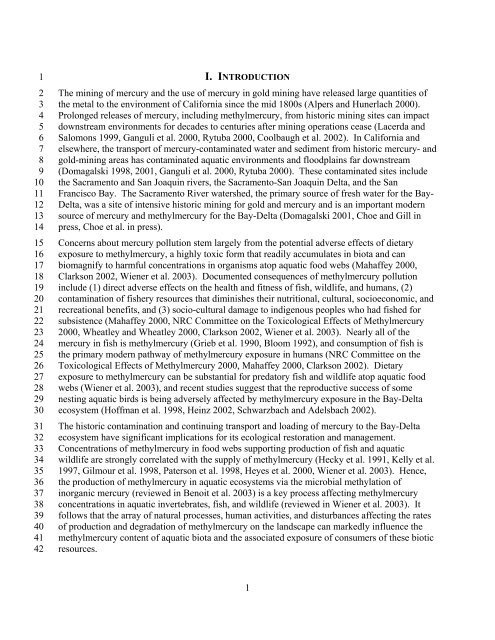Mercury Strategy for the Bay-Delta Ecosystem - CALFED Bay-Delta ...
Mercury Strategy for the Bay-Delta Ecosystem - CALFED Bay-Delta ...
Mercury Strategy for the Bay-Delta Ecosystem - CALFED Bay-Delta ...
You also want an ePaper? Increase the reach of your titles
YUMPU automatically turns print PDFs into web optimized ePapers that Google loves.
1<br />
2<br />
3<br />
4<br />
5<br />
6<br />
7<br />
8<br />
9<br />
10<br />
11<br />
12<br />
13<br />
14<br />
15<br />
16<br />
17<br />
18<br />
19<br />
20<br />
21<br />
22<br />
23<br />
24<br />
25<br />
26<br />
27<br />
28<br />
29<br />
30<br />
31<br />
32<br />
33<br />
34<br />
35<br />
36<br />
37<br />
38<br />
39<br />
40<br />
41<br />
42<br />
I. INTRODUCTION<br />
The mining of mercury and <strong>the</strong> use of mercury in gold mining have released large quantities of<br />
<strong>the</strong> metal to <strong>the</strong> environment of Cali<strong>for</strong>nia since <strong>the</strong> mid 1800s (Alpers and Hunerlach 2000).<br />
Prolonged releases of mercury, including methylmercury, from historic mining sites can impact<br />
downstream environments <strong>for</strong> decades to centuries after mining operations cease (Lacerda and<br />
Salomons 1999, Ganguli et al. 2000, Rytuba 2000, Coolbaugh et al. 2002). In Cali<strong>for</strong>nia and<br />
elsewhere, <strong>the</strong> transport of mercury-contaminated water and sediment from historic mercury- and<br />
gold-mining areas has contaminated aquatic environments and floodplains far downstream<br />
(Domagalski 1998, 2001, Ganguli et al. 2000, Rytuba 2000). These contaminated sites include<br />
<strong>the</strong> Sacramento and San Joaquin rivers, <strong>the</strong> Sacramento-San Joaquin <strong>Delta</strong>, and <strong>the</strong> San<br />
Francisco <strong>Bay</strong>. The Sacramento River watershed, <strong>the</strong> primary source of fresh water <strong>for</strong> <strong>the</strong> <strong>Bay</strong>-<br />
<strong>Delta</strong>, was a site of intensive historic mining <strong>for</strong> gold and mercury and is an important modern<br />
source of mercury and methylmercury <strong>for</strong> <strong>the</strong> <strong>Bay</strong>-<strong>Delta</strong> (Domagalski 2001, Choe and Gill in<br />
press, Choe et al. in press).<br />
Concerns about mercury pollution stem largely from <strong>the</strong> potential adverse effects of dietary<br />
exposure to methylmercury, a highly toxic <strong>for</strong>m that readily accumulates in biota and can<br />
biomagnify to harmful concentrations in organisms atop aquatic food webs (Mahaffey 2000,<br />
Clarkson 2002, Wiener et al. 2003). Documented consequences of methylmercury pollution<br />
include (1) direct adverse effects on <strong>the</strong> health and fitness of fish, wildlife, and humans, (2)<br />
contamination of fishery resources that diminishes <strong>the</strong>ir nutritional, cultural, socioeconomic, and<br />
recreational benefits, and (3) socio-cultural damage to indigenous peoples who had fished <strong>for</strong><br />
subsistence (Mahaffey 2000, NRC Committee on <strong>the</strong> Toxicological Effects of Methylmercury<br />
2000, Wheatley and Wheatley 2000, Clarkson 2002, Wiener et al. 2003). Nearly all of <strong>the</strong><br />
mercury in fish is methylmercury (Grieb et al. 1990, Bloom 1992), and consumption of fish is<br />
<strong>the</strong> primary modern pathway of methylmercury exposure in humans (NRC Committee on <strong>the</strong><br />
Toxicological Effects of Methylmercury 2000, Mahaffey 2000, Clarkson 2002). Dietary<br />
exposure to methylmercury can be substantial <strong>for</strong> predatory fish and wildlife atop aquatic food<br />
webs (Wiener et al. 2003), and recent studies suggest that <strong>the</strong> reproductive success of some<br />
nesting aquatic birds is being adversely affected by methylmercury exposure in <strong>the</strong> <strong>Bay</strong>-<strong>Delta</strong><br />
ecosystem (Hoffman et al. 1998, Heinz 2002, Schwarzbach and Adelsbach 2002).<br />
The historic contamination and continuing transport and loading of mercury to <strong>the</strong> <strong>Bay</strong>-<strong>Delta</strong><br />
ecosystem have significant implications <strong>for</strong> its ecological restoration and management.<br />
Concentrations of methylmercury in food webs supporting production of fish and aquatic<br />
wildlife are strongly correlated with <strong>the</strong> supply of methylmercury (Hecky et al. 1991, Kelly et al.<br />
1997, Gilmour et al. 1998, Paterson et al. 1998, Heyes et al. 2000, Wiener et al. 2003). Hence,<br />
<strong>the</strong> production of methylmercury in aquatic ecosystems via <strong>the</strong> microbial methylation of<br />
inorganic mercury (reviewed in Benoit et al. 2003) is a key process affecting methylmercury<br />
concentrations in aquatic invertebrates, fish, and wildlife (reviewed in Wiener et al. 2003). It<br />
follows that <strong>the</strong> array of natural processes, human activities, and disturbances affecting <strong>the</strong> rates<br />
of production and degradation of methylmercury on <strong>the</strong> landscape can markedly influence <strong>the</strong><br />
methylmercury content of aquatic biota and <strong>the</strong> associated exposure of consumers of <strong>the</strong>se biotic<br />
resources.<br />
1

















